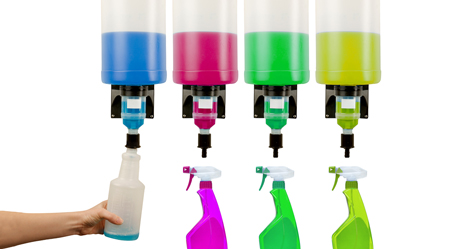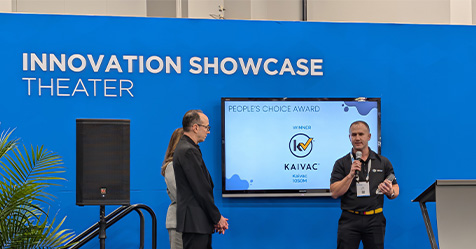As businesses continue to work out the details of pandemic protocols, owners and operators of commercial buildings are implementing new technologies to make their facilities safer, healthier, and cleaner. Many of these technologies have existed for years, while others are new or have been updated to meet today’s evolving needs.
To prepare for new operational protocols, building managers and cleaning and maintenance professionals should look closely at these building technologies. While procedures will differ depending on the specific products, the following list of some of the latest building technology trends can help guide employee education and training.
Air quality technologies
When it comes to a reassuring occupants, there is more than just the quality of air flow to consider. Although air carries the essential elements that allow us to breathe, it can also contain aerosolized pathogens, dust, volatile organic compounds, and other particulate matter. Boosting indoor air quality means increasing the flow of essential elements while effectively removing undesired particles. This goal is achieved through the right combination of ventilation, relative humidity, filtration, and pressurization.
As the desire for cleaner air becomes more prevalent and occupants request more transparency into the health of the built environment, owners and operators will likely need to adjust current systems and invest in new equipment. A few technologies in this category include:
- Electronic air cleaners (EACs): An electrostatic precipitator, also called an electronic air cleaner, uses an electric charge to remove impurities from the air without impeding air flow. These devices are installed at the point of air intake in an HVAC system, and can help remove and clean airborne particles before they circulate throughout a facility, reducing the potential spread of pathogens, bacteria, and contaminants. Maintenance of commercial EACs is often tool-free and relatively simple.
- Ventilation controls: Proper air exchange can dispel odors, chemicals, and carbon dioxide, while balancing energy use and reducing disease transmission. The American Society of Heating, Refrigerating and Air-Conditioning Engineers (ASHRAE) recommends adjusting ventilation to combat pathogen transmission in buildings. Economizers can bring in the right amount of fresh air based on environmental conditions, as well as meet building regulations. Newer economizers offer onboard fault detection and diagnostics to reduce service and commissioning time for maintenance professionals.
- Humidity sensors: Humidity sensors offer an automated method for keeping humidity at the optimal levels within a building. Humidity control is not just about occupant comfort, it also may reduce the transmission of certain airborne infectious organisms. High humidity can promote bacteria and mold growth, while low humidity can cause dry, itchy skin and upper respiratory irritations. ASHRAE research shows keeping relative humidity in the 40% to 60% range can decrease occupant exposure to infectious particles and reduce virus transmission.
- Pressurization controls: Maintaining proper pressurization in critical spaces, including restrooms, can help reduce pathogens, bacteria, viruses, and other microorganisms that can be present in indoor air. Pressurization also can contain air in a quarantined space or isolate and protect clean spaces; it creates precise, one-way airflow for more effective exchange and filtration, removing stagnant air where pathogens could linger. Pressure sensors provide low-maintenance measurement and control, while venturi valves help maintain consistent room pressure and directional air flow.
- UV systems: Ultraviolet (UV) systems use ultraviolet light to damage the DNA structure of certain microbes at the cellular level and inactivate various viral, bacterial, and fungal organisms, making them less likely to replicate and potentially spread disease. UV systems can be installed at HVAC coils or with an EAC to deactivate biological contaminants growing on cooling coils, preventing pathogens from spreading to building occupants.
Monitoring and occupant safety technologies
Installation of monitoring and safety technologies will likely continue to increase as building owners and operators seek to reassure occupants that it is safe to return. These technologies can be leveraged to not only detect individuals who may be sick but also to monitor for density and flow of people within a building. These technologies are also useful for contact tracing and to monitor policies like social distancing and mask wearing. A few of these technologies include:
- Frictionless access control: Frictionless controls can be based on factors like mobile credentials, zero-contact biometrics, and facial recognition software. Building occupants, including custodial and maintenance staff, can access buildings in a safer way by eliminating contact with some high touch surfaces like badge readers or doorknobs.
- Occupancy sensors: Sensors and video analytics integrated into security systems can count people entering and leaving a building or room to keep occupancy numbers to acceptable levels, supporting social distancing guidelines. For custodial staff, occupancy sensors can sense when occupants have left a room and send alerts to building management systems, indicating it is safe for staff to enter to clean and disinfect.
- Building management system monitoring: Analytics systems can be integrated into building management systems, allowing staff to monitor factors like air quality, humidity, pressure, and even occupant behavior through real-time data. Maintenance staff can quickly see and address system malfunctions that require maintenance.
- Video analytics: Temperature screening via thermal cameras tied into security systems can help identify people with elevated body temperatures and limit access to a building. Buildings that require masks indoors can use video analytics systems to screen for face mask compliance.
Many people are anxious about returning to the workplace and want detailed information on the steps building operators have implemented to create healthy spaces. Identifying methods to measure cleaning effectiveness and track procedure compliance will be key. Improving healthy air flow and monitoring protocol compliance are challenges that will go beyond increased cleaning procedures and schedules and evolve to standard building procedures going forward.




